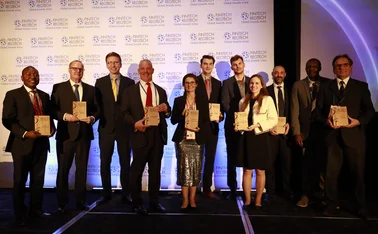
Economics in central banking: Matteo Maggiori, Brent Neiman and Jesse Schreger
Global Capital Allocation Project has helped pick apart tangled network of cross-border capital flows

More than a decade on from the 2008 financial crisis, most central bankers view the global banking system as far more resilient than it was. Work on Basel III is largely complete; capital and liquidity ratios have risen significantly; supervision of banks is much tougher. But, as central bankers are coming to realise, that is not the end of the story. In fact, as the latest figures from the Financial Stability Board show, it is only about half the story. Non-banks make up 48.5% of the global system. And understanding the scale and scope of the risks among non-banks is far more complicated than in the more closely scrutinised banking system.
However, relatively little is known about how these non-bank investors allocate capital globally, something Matteo Maggiori, Brent Neiman and Jesse Schreger realised when they worked together three years ago on a joint paper on international currencies and capital allocation.
“We noticed there was a paucity of integrated micro datasets and a lack of consistent treatment of country-level investment positions,” says Neiman, a professor of economics at the University of Chicago Booth School of Business. This made it very difficult to track flows of capital around the world, flows that are increasingly moving via bond markets and through the non-bank sector, often by way of tax havens.
From this realisation, the Global Capital Allocation Project was born. “We realised we liked working together, and there was scope to take this away from one academic paper into something much broader,” says Maggiori, an associate professor of finance at the Stanford Graduate School of Business.
The project brings together several strands of research on global capital flows, backed by new datasets that use innovative means of dealing with the opacity of parts of the global monetary system. The research, codes and data are all available for free on the project’s website, which launched in mid-2019.
For example, the economists use position-level data from mutual funds to report the currency shares of corporate issuances by countries. To shine a light on flows through offshore centres, they map bond issuance offshore to parent companies, creating a matrix of interlinkages that can be used to translate data from a residency to a nationality basis.
Achieving this required an “immense” amount of data crunching, notes Kristin Forbes, a professor at the Massachusetts Institute of Technology, who has been following the project. “In the economics profession, this type of careful and tedious work is often not rewarded – but is the basis for good empirical work and truly understanding the world.”
The results have already been impressive, with significant implications for global policy-makers. Maggiori, Neiman and Schreger were some of the first to notice the rising dominance of the US dollar after 2008. “Since 2008, the dollar share in cross-border corporate bond positions has increased by 20 percentage points, while the euro’s share has collapsed by the same amount,” says Maggiori. This raises financial stability risks for countries that borrow in dollars – ie, most of the world.
Schreger says it was “shocking” to discover how much money was flowing through tax havens, which meant data on country exposures was seriously inaccurate
Their work challenges some of the prevailing wisdom that emerging markets are the main jurisdictions loading up on dollar debt. “About 85% of US investment into European corporate bonds is in dollars,” says Maggiori. “This affects not only the currency exposure, but also the type of firms in Europe that the US invests in.”
Their more recent work has focused on tax havens. Schreger, an assistant professor of macroeconomics in the Economics Division at Columbia Business School, says it was “shocking” to discover how much money was flowing through these jurisdictions, which meant data on country exposures was seriously inaccurate. “Discovering the true risk exposures that are masked by tax havens affects our understanding of global imbalances and north-to-south flows. It is an important first step,” he says.
Shedding light on the issue has implications for policy. The authors’ paper presenting the work on tax havens shows that exposures in some countries are dramatically larger than regulators realised. In particular, flows from developed countries to emerging markets, including Brazil, China, India and Russia, are much larger than headline statistics imply.
The gap between the headline figures and the revised ones is “truly quite gigantic”, says Maggiori. This means some countries are much more vulnerable than they seem. For example, the equity stake of US investors in Chinese companies jumps by more than $500 billion when it is translated from a residency to a nationality basis.
Forbes, who previously sat on the Bank of England’s Monetary Policy Committee, says the opportunities to draw new insights from the data are huge: “I am looking forward to seeing how it could revise our views and understanding on a whole host of international financial issues. They have only scratched the surface. Many young economists could construct whole careers with this data.”
Maggiori, Neiman and Schreger are already working on scaling up their team and the overall project, as well as presenting their findings to a wide range of policy-makers – from the US’s Congressional Budget Office to the Bank for International Settlements, and many central banks. In the next six months, they hope to broaden the dialogue – longer term, they hope the project leaves its mark on global policy, as well as on academic economics.
The work comes at a crucial moment for the global system, with many senior central bankers, such as BoE governor Mark Carney, warning of dangerous imbalances emerging from the US dollar’s dominance and the growing role of illiquid investment funds in financial intermediation. With the global financial safety net widely seen as inadequate, and the US pulling back from its leadership role in global governance, understanding how trouble could spread through the system is vital. The Global Capital Allocation Project looks set to be a valuable resource for central bankers working to guard against the next crisis.
The Central Banking Awards were written by Christopher Jeffery, Daniel Hinge, Dan Hardie, Rachael King, Victor Mendez-Barreira, Alice Shen and William Towning
Only users who have a paid subscription or are part of a corporate subscription are able to print or copy content.
To access these options, along with all other subscription benefits, please contact info@centralbanking.com or view our subscription options here: http://subscriptions.centralbanking.com/subscribe
You are currently unable to print this content. Please contact info@centralbanking.com to find out more.
You are currently unable to copy this content. Please contact info@centralbanking.com to find out more.
Copyright Infopro Digital Limited. All rights reserved.
As outlined in our terms and conditions, https://www.infopro-digital.com/terms-and-conditions/subscriptions/ (point 2.4), printing is limited to a single copy.
If you would like to purchase additional rights please email info@centralbanking.com
Copyright Infopro Digital Limited. All rights reserved.
You may share this content using our article tools. As outlined in our terms and conditions, https://www.infopro-digital.com/terms-and-conditions/subscriptions/ (clause 2.4), an Authorised User may only make one copy of the materials for their own personal use. You must also comply with the restrictions in clause 2.5.
If you would like to purchase additional rights please email info@centralbanking.com






